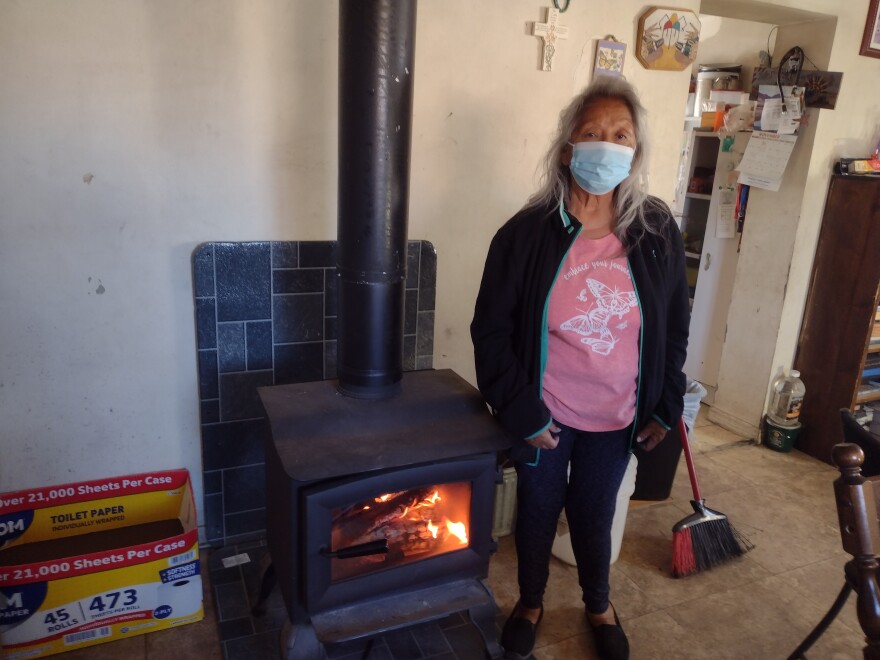This is the fourth winter since the Kayenta Coal Mine closed and left Hopi residents without a reliable source of heat for their homes. Many tribal members have switched from coal to wood to keep warm, but the transition hasn’t been easy. KNAU’s Melissa Sevigny reports, nonprofits have stepped up to help.
When word came of a firewood giveaway in Flagstaff, Matt Honanie woke at 4 am to make the two-hour drive from Hopi and get in line. He and his wife waited for hours, only to be turned away.
“On the drive home, being sad and all,” Honanie remembers, “she kind of came up with an idea, why can’t we help our own people?... When my wife has an idea, I just got to make it happen for her.”
That was the birth of Koho4Hopi, a grassroots nonprofit to supply firewood to Hopi people. It’s one of sixty organizations that partners with Wood for Life, a collaborative initiative including the National Forest Foundation and Coconino National Forest designed to pair forest restoration work with tribal firewood needs.
In Kykotsmovi Village, volunteers cut and stack logs that will be sold at a steep discount or given away. “For myself and my wife,” Honanie explains, “it’s not really working for that money, it’s more working for the smiles, the thank you's, the askwali's, the kwah'kwa's.”
The pine trees now on the chopping block were killed by recent wildfires. They’re huge but Honanie says the wood won’t last long. “It’s just one of those things where we have to pick and choose who we give it to… It’s hard thing to think about, because a lot of the elders are the ones really suffering,” he says.
Elders like Patricia Selestewa, who lives in the village of Hotevilla with her 13 and 14-year-old grandsons. Many homes here don’t have electricity, including her own.
“Since I can’t burn coal, I have to buy wood, but with limited income, and it costs a lot…” she says. She worries about running out of firewood before this winter is over, “especially if we don’t have no trucks or no chainsaws… and my grandsons are too young, I don’t think they would be able to use a chainsaw.”

The woodstove in Selestewa’s home was a gift from Red Feather Development Group. The nonprofit has swapped out about sixty outdated coal stoves for EPA-certified wood stoves. It also hires contractors to add insulation and plug up holes.
Alfred Lomahquahu is a program coordinator. He says, “One of the major problems on Hopi is the lack of employment. So a lot of the younger generation are moving off. That leaves a lot of older generation to try to fend for themselves.”
Plus, the tribal government lost more than 80 percent of its revenue when Kayenta Coal Mine shut down in 2019. The pandemic hit just months later.
“The services are really declining on what they can do for the people, each village, so that compounds everything,” Lomahquahu says. “So now you see a lot more nonprofits stepping up.”
Kiera Coughlan, also of Red Feather, says their work is funded by donations and grants, though she hopes more money will come from the Inflation Reduction Act. “Our dream is like—imagine if we could just do everybody. The hundreds of people we have our wait list. Everybody gets a stove if they don’t have electricity, if they do, they get a mini-split,” she says.
Mini-split heaters are ideal, since there’s no need to chop wood, no risk of chimney fires and no health hazard from breathing in smoke. Red Feather installed 52 mini-splits on the Hopi and Navajo Nations last year, with funding from Arizona Public Service.

Laurel Poleyestewa got one. “I really, really like it,” she says. “It’s awesome. It’s like my prayers were answered, all I have to do is click a button and it gets warm in here.”
Poleyestewa used to hang up plastic sheets and hole up in her bedroom to stay warm. Now she doesn’t worry her grandkids will be cold when they come to visit. But she says she still feels a bit hopeless. “For a while there, everyone was scrambling, and it just seems like now nobody’s thinking about it, and people are still trying to stay warm.”
She says many community members and outsiders have stepped in to help, but there’s still so few resources and so many people in need.







